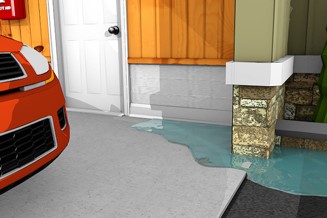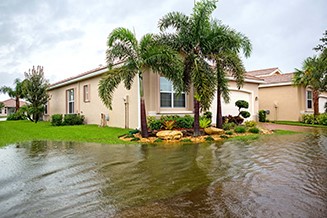Did you know?
Most of the catastrophic flooding in coastal Texas by Hurricane Harvey in 2017 wasn’t ocean water from the storm surge. It came from the more than 50 inches of rain. In fact, it was the single biggest rain event in recorded history for the continental United States.
Of course, that’s one extreme example of the damage that heavy rain can do to your property. But heavy rains can cause damage in other unexpected ways. Flooding from the ground up isn’t the only risk of damage to your home when it comes to heavy rain. Earlier this year, heavy rains caused flash flooding in Vermont. The flooding was a result of water rolling down from the mountains – not coming up from the rivers. But the damage to property was extensive nonetheless. And yet these are just two of many ways that heavy rain can damage your home.
The American Insurance Association reports that water damage is the second-most frequently filed insurance claim in the United States. And flooding from the ground up isn’t the only risk of damage to your home when it comes to heavy rain.
Unfortunately, some types of heavy rain-related damage to your home is not covered by your homeowners insurance policy. The reason is that groundwater from rain is considered a flood in the homeowners policy. And standard homeowners policies do not cover flood damage. Read on to understand your risks and what you can do to help guard against this big insurance “gotcha.”
Top Tips for Protecting Your Home from Heavy Rain Damage
- Clean your gutters and downspouts. This is basic maintenance for homeowners, but because you likely can’t see inside your gutters most of the time, they can easily be overlooked. Gutters are designed to direct water from your roof away from the foundation or other vulnerable areas. When leaves, twigs, and other debris collect in gutters and downspouts, water runoff from the roof backs up. With nowhere to go, heavy rain can damage your roof or allow water to collect around your foundation, a bulkhead, or even a window.
- Install French drains. A French drain, also called a rock drain, can help prevent basement or crawl-space flooding by redirecting groundwater away from the foundation. This is especially helpful if your property has even a slight slope. In simple terms, a perforated pipe is placed at the bottom of a narrow trench that’s dug around the perimeter of your home. Gravel or rock is filled in over the pipe and enables water to drain easily into the pipe, which redirects the water away from at-risk areas.
- Install (and maintain) a sump pump. This preventive measure is important, especially if your basement (or crawl space) is below the water table. Sump pumps are activated automatically when water starts to accumulate in their specifically recessed location in the floor. Be sure to test the pump ahead of anticipated heavy rains or other storms, because a failed pump won’t be covered in your homeowners insurance policy without a special endorsement.
- Do a roof health checkup. This is another simple preventive measure, but it’s one that can make a big difference. How old is your roof? Are there any damaged or missing shingles? Be sure your roof is in top shape; it’s literally the first line of defense when it comes to heavy rain.
What to Do Now
Contact one of our Risk Coaches to discuss protecting your property with a flood policy from the National Flood Insurance Program. If you have a sump pump, ask about the endorsement that will protect your property if the pump fails or is overwhelmed by the volume of the water. We’re available at 800.227.2757 Monday through Friday, from 8:00 a.m. to 8:00 p.m. ET., or by email at any time at Service@ElectricInsurance.com.





